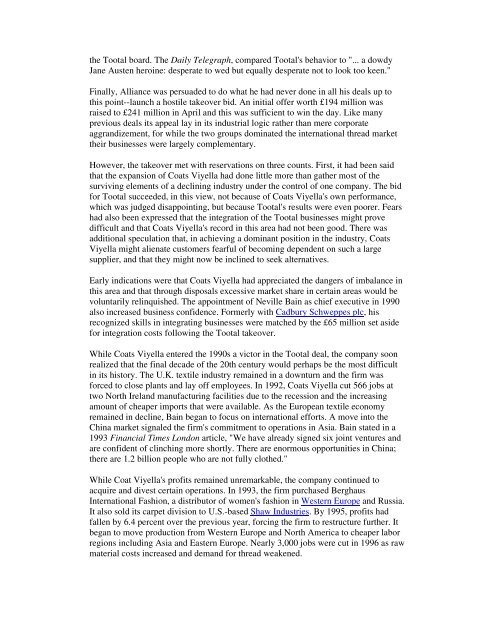Microsoft Word -Potted history of Coats plc - Coats Pension Plan
Microsoft Word -Potted history of Coats plc - Coats Pension Plan
Microsoft Word -Potted history of Coats plc - Coats Pension Plan
Create successful ePaper yourself
Turn your PDF publications into a flip-book with our unique Google optimized e-Paper software.
the Tootal board. The Daily Telegraph, compared Tootal's behavior to "... a dowdy<br />
Jane Austen heroine: desperate to wed but equally desperate not to look too keen."<br />
Finally, Alliance was persuaded to do what he had never done in all his deals up to<br />
this point--launch a hostile takeover bid. An initial <strong>of</strong>fer worth £194 million was<br />
raised to £241 million in April and this was sufficient to win the day. Like many<br />
previous deals its appeal lay in its industrial logic rather than mere corporate<br />
aggrandizement, for while the two groups dominated the international thread market<br />
their businesses were largely complementary.<br />
However, the takeover met with reservations on three counts. First, it had been said<br />
that the expansion <strong>of</strong> <strong>Coats</strong> Viyella had done little more than gather most <strong>of</strong> the<br />
surviving elements <strong>of</strong> a declining industry under the control <strong>of</strong> one company. The bid<br />
for Tootal succeeded, in this view, not because <strong>of</strong> <strong>Coats</strong> Viyella's own performance,<br />
which was judged disappointing, but because Tootal's results were even poorer. Fears<br />
had also been expressed that the integration <strong>of</strong> the Tootal businesses might prove<br />
difficult and that <strong>Coats</strong> Viyella's record in this area had not been good. There was<br />
additional speculation that, in achieving a dominant position in the industry, <strong>Coats</strong><br />
Viyella might alienate customers fearful <strong>of</strong> becoming dependent on such a large<br />
supplier, and that they might now be inclined to seek alternatives.<br />
Early indications were that <strong>Coats</strong> Viyella had appreciated the dangers <strong>of</strong> imbalance in<br />
this area and that through disposals excessive market share in certain areas would be<br />
voluntarily relinquished. The appointment <strong>of</strong> Neville Bain as chief executive in 1990<br />
also increased business confidence. Formerly with Cadbury Schweppes <strong>plc</strong>, his<br />
recognized skills in integrating businesses were matched by the £65 million set aside<br />
for integration costs following the Tootal takeover.<br />
While <strong>Coats</strong> Viyella entered the 1990s a victor in the Tootal deal, the company soon<br />
realized that the final decade <strong>of</strong> the 20th century would perhaps be the most difficult<br />
in its <strong>history</strong>. The U.K. textile industry remained in a downturn and the firm was<br />
forced to close plants and lay <strong>of</strong>f employees. In 1992, <strong>Coats</strong> Viyella cut 566 jobs at<br />
two North Ireland manufacturing facilities due to the recession and the increasing<br />
amount <strong>of</strong> cheaper imports that were available. As the European textile economy<br />
remained in decline, Bain began to focus on international efforts. A move into the<br />
China market signaled the firm's commitment to operations in Asia. Bain stated in a<br />
1993 Financial Times London article, "We have already signed six joint ventures and<br />
are confident <strong>of</strong> clinching more shortly. There are enormous opportunities in China;<br />
there are 1.2 billion people who are not fully clothed."<br />
While Coat Viyella's pr<strong>of</strong>its remained unremarkable, the company continued to<br />
acquire and divest certain operations. In 1993, the firm purchased Berghaus<br />
International Fashion, a distributor <strong>of</strong> women's fashion in Western Europe and Russia.<br />
It also sold its carpet division to U.S.-based Shaw Industries. By 1995, pr<strong>of</strong>its had<br />
fallen by 6.4 percent over the previous year, forcing the firm to restructure further. It<br />
began to move production from Western Europe and North America to cheaper labor<br />
regions including Asia and Eastern Europe. Nearly 3,000 jobs were cut in 1996 as raw<br />
material costs increased and demand for thread weakened.



